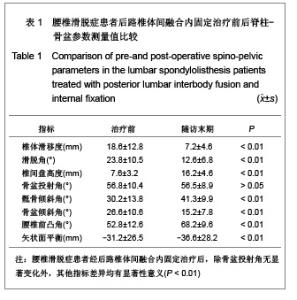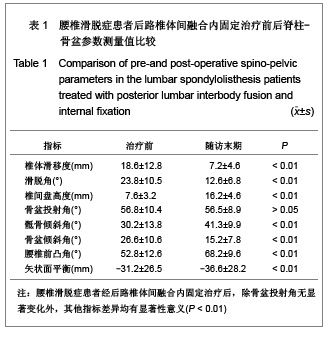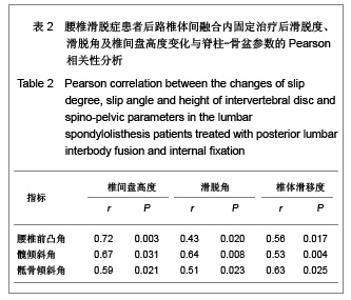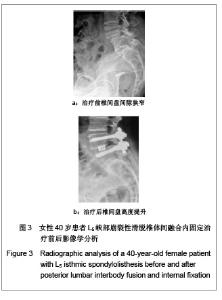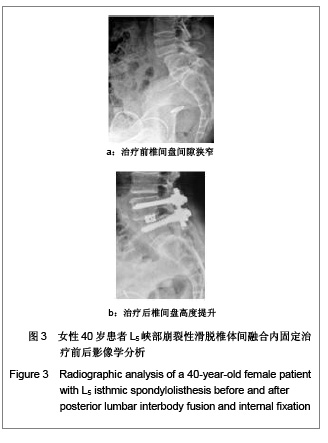| [1] Bose B, Balzarini M, Gimmestad G, et al. Uninstmmented posterolateml fusion as an adjunct to interbody fusion. Neumsurgery Quanerly. 2004; 14(3):174-178.[2] Ruan DK, He Q, Ding N, et al. Zhongguo Jizhu Jisui Zazhi. 2004;14(3):156-160. 阮狄克,何琼,丁宁,等. PLF与PLIF手术治疗腰椎滑脱症的疗效比较[J].中国脊柱脊髓杂志, 2004,14(3):156-160.[3] Fan SW, Fang XQ, Zhang HJ, et al. Zhonghua Guke Zazhi. 2006;26(2):105-109. 范顺武,方向前,张宏军,等.椎间隙撑开在腰椎滑脱症复位和融合中的应用价值[J]. 中华骨科杂志, 2006,26(2):105-109.[4] Wu Y, Tang H, Li Z, et al. Outcome of posterior lumbar interbody fusion versus posterolateral fusion in lumbar degenerative disease. J Clin Neurosci. 2011; 18(6): 780-783.[5] Musluman AM, Yilmaz A, Cansever T, et al. Posterior lumbar interbody fusion versus posterolateral fusion with instrumentation in the treatment of low-grade isthmic spondylolisthesis: midterm clinical outcomes. J Neurosurg Spine. 2011;14(4):488-496. [6] Kaito T, Hosono N, Mukai Y, et al. Induction of early degeneration of the adjacent segment after posterior lumbar interbody fusion by excessive distraction of lumbar disc space. J Neurosurg Spine. 2010;12(6):671-679. [7] Oh SK, Lee CS, Chung SS. Correlation of pelvic parameters with isthmic spondylolisthesis. Asian Spine J. 2009;3(1): 21-26.[8] Mac-Thiong JM, Wang Z, de Guise JA, et al. Postural model of sagittal spino-pelvic alignment and its relevance for lumbosacral developmental spondylolisthesis. Spine. 2008; 33(21):2316-2325.[9] Vialle R, Ilharreborde B, Dauzac C, et al. Is there a sagittal imbalance of the spine in isthmic spondylolisthesis? A correlation study. Eur Spine J. 2007;16(10):1641-1649.[10] Labelle H, Roussouly P, Berthonnaud E, et al. The importance of spino-pelvic balance in L5-S1 developmental spondylolisthesis: a review of pertinent radiologic measurements. Spine. 2005;30(6 Suppl):S27-34.[11] Meyerding H. Low backache and sciatic pain associated with spondylolisthesis and protruded intervertebral disc: incidence, significance and treatment. J Bone Joint Sur (Am). 1947; 29(2): 461-470. [12] Labelle H, Roussouly P, Berthonnaud E, et al. Spondylolisthesis, pelvic incidence, and spinopelvic balance: a correlation study. Spine. 2004; 29(18):2049-2054. [13] Kim KT, Suk KS, Cho YJ, et al. Clinical outcome results of pedicle subtraction osteotomy in ankylosing spondylitis with kyphotic deformity. Spine. 2002; 27(6): 612-618.[14] Rose PS, Bridwell KH, Lenke LG, et a1. Role of pelvic incidence, thoracic kyphosis, and patient factors on sagittal plane correction following pedicle subtraction osteotomy. Spine. 2009;34(8):785-791.[15] Legaye J, Duval-Beaupere G, Hecquet J, et al. Pelvic incidence: a fundamental pelvic parameter for three-dimensional regulation of spinal sagittal curves. Eur Spine J. 1998;7(2):99-103.[16] Park SJ, Lee CS, Chung SS, et al. Postoperative changes of pelvic parameters and sagittal balance in adult isthmic spondylolisthesis. Neurosurgery. 2011; 68(2):355-363.[17] Hanson DS, Bridwell KH, Rhee JM, et al. Correlation of pelvic incidence with low- and high-grade isthmic spondylolisthesis. Spine. 2002; 27(18):2026-2029. [18] Roussouly P, Gollogly S, Berthonnaud E, et al. Sagittal alignment of the spine and pelvis in the presence of L5-S1 isthmic lysis and low-grade spondylolisthesis. Spine. 2006; 31(21):2484-2490.[19] Rajnics P, Templier A, Skalli W, et al. The association of sagittal spinal and pelvic parameters in asymptomatic persons and patients with isthmic spondylolisthesis. J Spinal Disord Tech. 2002; 15(1):24-30.[20] Marty C, Boisaubert B, Descamps H, et al. The sagittal anatomy of the sacrum among young adults, infants, and spondylolisthesis patients. Eur Spine J. 2002; 11(2):119-125. [21] Jackson RP, Peterson MD, McManus AC, et al. Compensatory spinopelvic balance over the hip axis and better reliability in measuring lordosis to the pelvic radius on standing lateral radiographs of adult volunteers and patients. Spine. 1998; 23(16):1750-1767. [22] Labelle H, Roussouly P, Chopin D, et al. Spino-pelvic alignment after surgical correction for developmental spondylolisthesis. Eur Spine J. 2008; 17(9):1170-1176.[23] Hresko MT, Hirschfeld R, Buerk AA, et al. The effect of reduction and instrumentation of spondylolisthesis on spinopelvic sagittal alignment. J Pediatr Orthop. 2009; 29(2):157-162.[24] Kawakami M, Tamaki T, Ando M, et al. Lumbar sagittal balance influences the clinical outcome after decompression and posterolateral spinal fusion for degenerative lumbar spondylolisthesis. Spine. 2002; 27(1):59-64.[25] Boachie-Adjei O, Do T, Rawlins BA. Partial lumbosacral kyphosis reduction, decompression, and posterior lumbosacral transfixation in high-grade isthmic spondylolisthesis: clinical and radiographic results in six patients. Spine. 2002; 27(6):E161-168.[26] Godde S, Fritsch E, Dienst M, et al. Influence of cage geometry on sagittal alignment in instrumented posterior lumbar interbody fusion. Spine. 2003; 28(15):1693-1699.[27] Vaz G, Roussouly P, Berthonnaud E, et al. Sagittal morphology and equilibrium of pelvis and spine. Eur Spine J. 2002; 11(1):80-87. |


